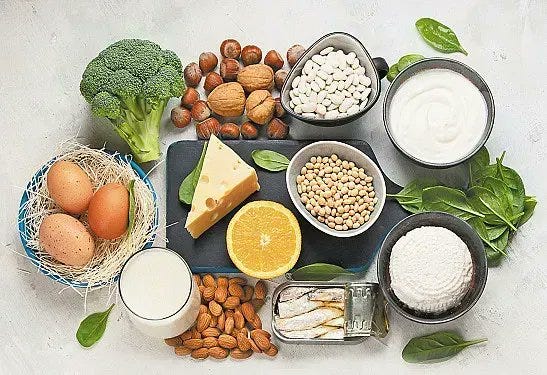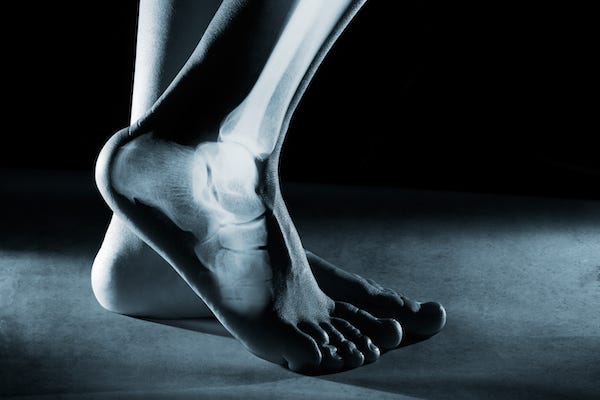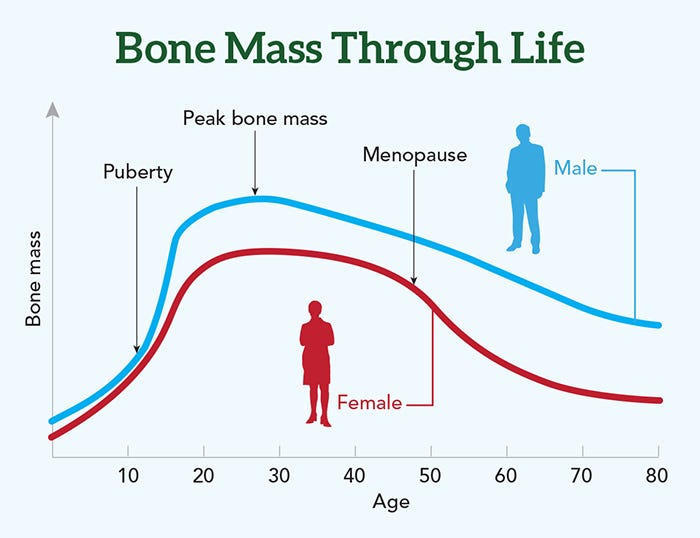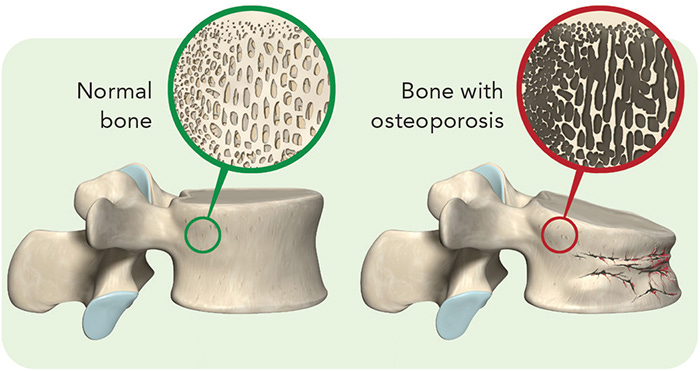10 Critical Nutrients To Keep Your Bones Strong
We don’t often give much thought to our bones – until we happen to break one or experience bone pain. It’s important to keep in mind that bones are living, dynamic, and constantly changing tissues.
While it’s never too late to start building or maintaining your bone density, it is advisable to improve your bone status early in life. Why? Because roughly 20 percent of women and 4 percent of men aged 50 or older have osteoporosis, or brittle bones. Another 50 percent of women and 30 percent of men 50 or older have osteopenia, or low bone mass.
That’s perhaps one of the most worrisome aspects of aging; realizing that someday, you could be plagued by excruciating pain that is literally unnecessary. Bone is constantly remodeling during our lifetime - rebuild, bit by bit, because microfractures and little vascular changes can make it less structurally sound. So until we reach our peak age, we are laying down more bone than we’re taking away and peak bone mass is achieved at around 25 to 30 years of age.
However, past this point, your body’s capacity to absorb and utilize calcium to further build up the bone mass diminishes. This is where small declines start to happen, with men losing about 1 percent a year from age 50 or so throughout their lives. Women at menopause will lose bone rapidly for about five to eight years, sometimes at a 2-3 percent loss per year, triggered by the loss of estrogen. After that, it slows down to around 1 percent a year.
Osteoperosis
This is a condition where the body either loses too much bone or makes too little bone or simply does both. The resulting decrease in bone density and increase in deterioration means you can no longer count on your skeleton to withstand even routine stress. A twist, a bend, an unexpected jolt — all can snap a vulnerable bone. (Harvard Health)
Osteoarthritis
Another extension of osteoporosis, osteoarthritis is a form of arthritis (swelling and tenderness of joints), which happens when the protective cartilage responsible for cushioning the bone ends wears off over time. It can lead to joint pain and bending or deformation of bones and difficulty in walking. (Healthshots.com)
As we know, exercise is a critical component of bone health, as it strengthens them the more we do. But what about nutrition?


Here are some of the most important nutrients (from foods) you need for good bone health:
Calcium - a major building block of our bone tissue, and our skeleton houses 99 percent of our body’s calcium stores. It plays numerous roles in our body, including building and maintaining bones and teeth, cardiovascular function, cell signaling, and muscle contraction. Food Sources: Dairy products provide the most concentrated sources of calcium. But you can also find it in almonds, spinach, kale, broccoli, and canned fish that includes soft bones (like sardines and salmon). Here is a list of the top 15 calcium rich foods.
Phosphorus - the second most abundant mineral in the human body, with eighty-five percent of it housed in the skeleton. The average intake of
phosphorus in US adults ranges between 1,000 and 1,500 milligrams per day, well above the RDA of 700 milligrams per day. Food sources are non-genetically-modified soy, legumes, whole grains, dairy, nuts, and seeds.
Magnesium - approximately 60 percent of magnesium in the human body is stored in the skeleton, making up about 1 percent of mineralized bone tissue. Magnesium plays a key role in converting vitamin D into the active form that promotes calcium absorption. Studies show that those who consume about 400-600 mg of daily magnesium tend to have 2–3 percent higher bone density than those who do not. Surprisingly, magnesium is only found in small amounts in most foods, so supplementing with magnesium glycinate is very beneficial. Food sources are whole grains and legumes, almonds, cashews, hazelnuts, beets, collards, and kelp.
Fluoride - known mostly as the mineral that combats tooth decay. It assists in tooth and bone development and maintenance, and also stimulates new bone growth. Fluoride content in foods depends on whether it was grown in soils and water that contained fluoride. Food sources are seafood (because the ocean contains natural sodium flouride, or natural mineral drops from sea source. The IOM has given an Adequate Intake (AI) for fluoride of 4 mg/day, (based on reduced incidence of cavities) but there is no developed RDA.
Vitamin D - Vitamin D helps your body absorb calcium and protects against osteopenia, osteoporosis and promotes bone health. You may be able to get enough vitamin D through sun exposure and food sources. However, many people need to supplement as well due to geographic location, ethnicity or just not getting enough exposure to the sun. I recommend up to 5,000 IU of vitamin D daily for my clients to maintain optimal levels, as there is no observable adverse effect level (NOAEL) is 10,000 IU per day (IOM 2010). Food sources are salmon, mackerel, tuna, sardines, mushrooms, cod liver oil, egg yolks, and fortified milk, yogurt, and cheese.
** Another important point is to have your physician administer a calcidiol test (also known as a 25-hydroxyvitamin D test). More important than your daily intake of vitamin D are your actual vitamin D blood levels. Optimal vitamin D blood levels are between 100 nmol/L to 150 nmol/L according to 40 of the top Vitamin D researchers at GrassrootsHealth.
Vitamin K - Vitamin K2 should always accompany vitamin D intake. Research used from the PubMed and Google Scholar databases within the last 20 years, shows a majority of studies reporting that vitamin K provides an essential role in promoting bone health.
** The most common forms of vitamin K2 are MK-4 and MK-7. MK-4 exists in small amounts in liver, eggs and meat. Fermented foods like cheese, sauerkraut and a soybean product called natto contain MK-7. Food sources are kale, spinach, turnip, and other dark leafy vegetables.
Boron - this mineral is increasingly recognized as an element that has several health benefits including bone health, stabilizing and extending the half-life of vitamin D and estrogen. Approximately half the population in the United States consumes less than 1 mg of Boron per day, but supplementation with 3 mg per day has demonstrated improved calcium and magnesium retention. It’s reasonable to supplement with this amount as no toxicity has been identified and excess is rapidly excreted in the urine. Food sources are avocado, nuts, peanut butter, green and orange vegetables, grapes, and raisins.
Iron - helps enzymes and regulators function properly so the body can form optimal bone structure for bone strength. Food sources are red meat, egg yolks, dark leafy vegetables, dried fruit, iron-fortified foods, beans, lentils, chick peas, liver, and artichoke.
Vitamin C - helps in formation of optimal bone structure and strength. Food sources are citrus fruits, tomatoes and tomato juice, potatoes, Brussel sprouts, cauliflower, broccoli, strawberries, cabbage, and spinach.
Zinc - the trace mineral zinc is needed in only very small amounts. It promotes the formation of bone-building cells and prevents the excessive breakdown of bone. Studies have shown that zinc supplements support bone growth and the maintenance of bone density in older adults. Food sources are wheat germ, pumpkin seeds, squash, spinach, flax seeds, watermelon seeds, beans, sesame seeds, tahini, beef, lamb.
More Tips For Bone Loss Prevention
1. Eat An Alkaline Diet
The typical U.S. diet contains 60 percent refined foods, making it highly acidic. In contrast, metabolizing fruits and vegetables produces potassium bicarbonate and other alkali. An acid diet leads to bone loss as even a subtle increase in the body’s acid levels will trigger the process of bone breakdown.
Interestingly there are two trials of people receiving potassium or sodium bicarbonate and bone resorption went down. So if you eat a high intake of green and yellow vegetables, that’s linked to increased bone mineralization during childhood and the maintenance of bone mass in young adults, with studies showing 20 percent lower risk of osteoporosis with high vegetable consumption.
2. Train for Strength
One of the best types of activity for bone health is weight-bearing or high-impact exercise, which promotes the formation of new bone, even in older adults. Studies show increases in bone mineral density, bone strength and bone size, as well as reductions preventing bone loss and reducing inflammation.
Strength-training exercise is beneficial for increasing muscle mass because it loads the skeleton and helps against bone loss in younger and older women, including those with osteoporosis and osteopenia.
3. Get Your Protein
Getting sufficient protein is important for healthy bones, as about 50 percent of bone is made of protein. Ignore this advice at your risk as it leads to decreased calcium absorption and may also affect rates of bone formation and breakdown. Since protein is fairly acidic, make sure to also eat plenty of fruits and veggies.
4. Take a Collagen Supplement
Research suggests that collagen supplements may help protect joints, bone health and is helpful for conditions such as arthritis. It contains the amino acids glycine, proline and lysine, which help build bone, muscle, ligaments and other tissues.
Collagen hydrolysate comes from animal bones; commonly known as gelatin and is used to relieve joint pain.
A 24-week study found that giving postmenopausal women with osteoporosis a combination of collagen and the hormone calcitonin led to a significant reduction in markers of collagen breakdown.
5. Consume Foods High in Omega-3 Fats
Omega-3 fatty acids have been shown to help protect against bone loss during the aging process. But in addition to including omega-3 fats in your diet, it’s also important to make sure your balance of omega-6 to omega-3 fats isn’t too high as this actually tends to lower bone density. Good plant sources of omega-3 fats include chia seeds, flaxseeds and walnuts.
6. Take a Mineral Supplement
Traditionally, eating fresh grains, fruits, and vegetables grown in nutrient-rich soil provided an adequate supply of the full spectrum of ionically-charged minerals. Unfortunately, today naturally-occurring, nutrient-rich soil is not what most food is grown in. Vegetation growth and aggressive modern farming techniques have brought many of the earth's minerals to the surface where they have been washed away. Synthesized fertilizers are routinely applied to farms and fields where minerals have been depleted and man-made fertilizers provide only enough mineral substance to support basic plant life. Numerous trace minerals that are so essential to human life are never replenished. Thankfully we have inexpensive supplements to make up for those losses.
I take a product called Trace Concentrate as it contains a full spectrum of trace and ultra-trace elements in ionic form. I receive no compensation (and offer no links) for this product, only mentioning it as a public service. Other products are available.
Ingredients: In approximate descending order:
Magnesium, Chloride, Potassium, Sulfate, Sodium, Boron, Bromide, Calcium, Carbonate, Silicon, Nitrogen, Selenium, Phosphorus, Iodine, Chromium, Iron, Manganese, Titanium, Rubidium, Cobalt, Copper, Antimony, Molybdenum, Strontium, Zinc, Nickel, Tungsten, Scandium, Tin, Lanthanum, Yttrium, Silver, Gallium, Zirconium, Vanadium, Beryllium, Tellurium, Bismuth, Hafnium, Terbium, Europium, Gadolinium, Samarium, Cerium, Cesium, Gold, Dysprosium, Holmium, Lutetium, Erbium, Ytterbium, Neodymium, Praseodymium, Niobium, Tantalum, Thorium, Thallium, Rhenium, plus other minerals found in seawater.
Directions
Add 10 to 20 drops to a glass of water or beverage, once or twice a day. To remineralize distilled or reverse osmosis water, add 5 to 10 drops per litre.
Remember, we live in a poisoned and depleted world. Without education and effort, suffering inevitably comes upon us. All the best in your quest to strengthen your bones.








